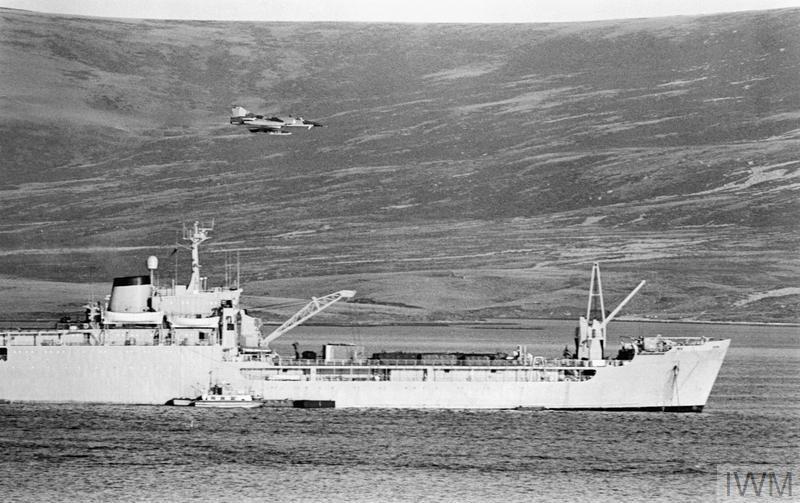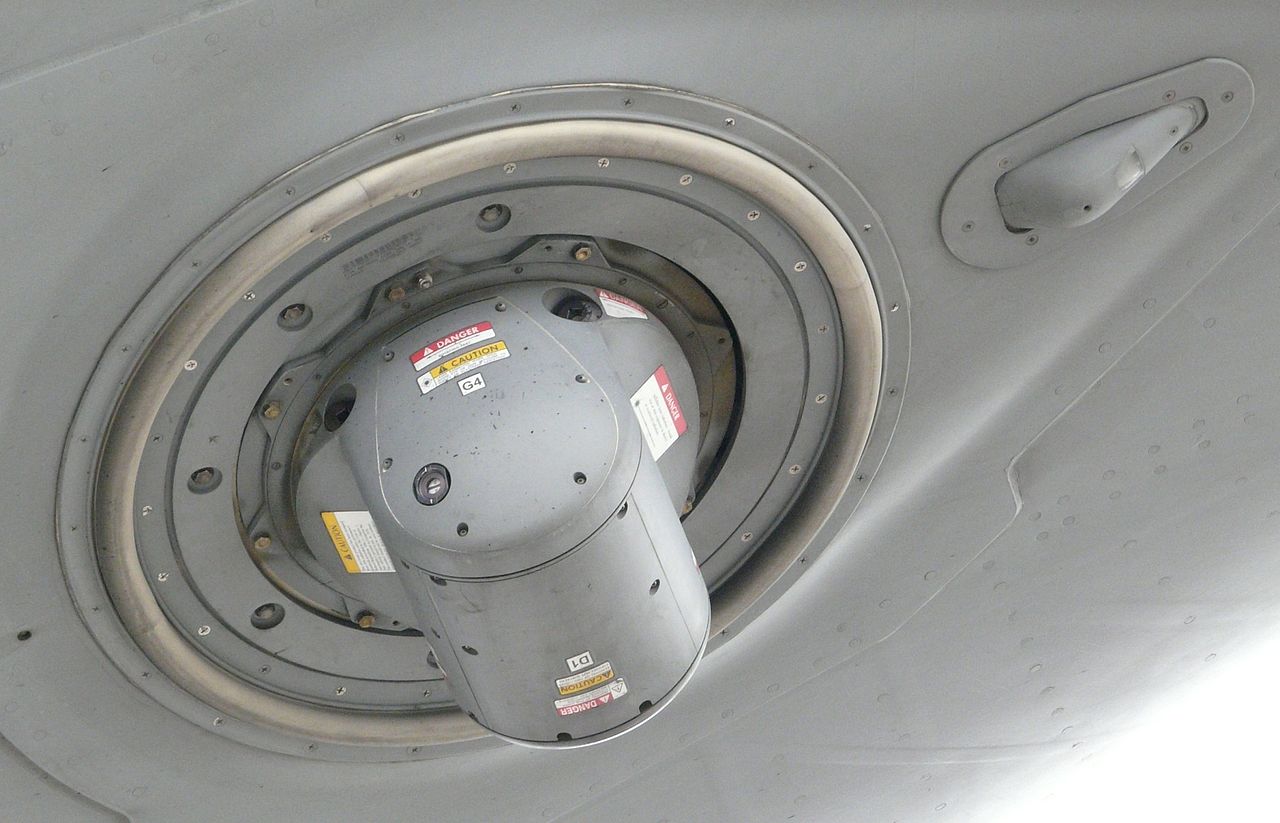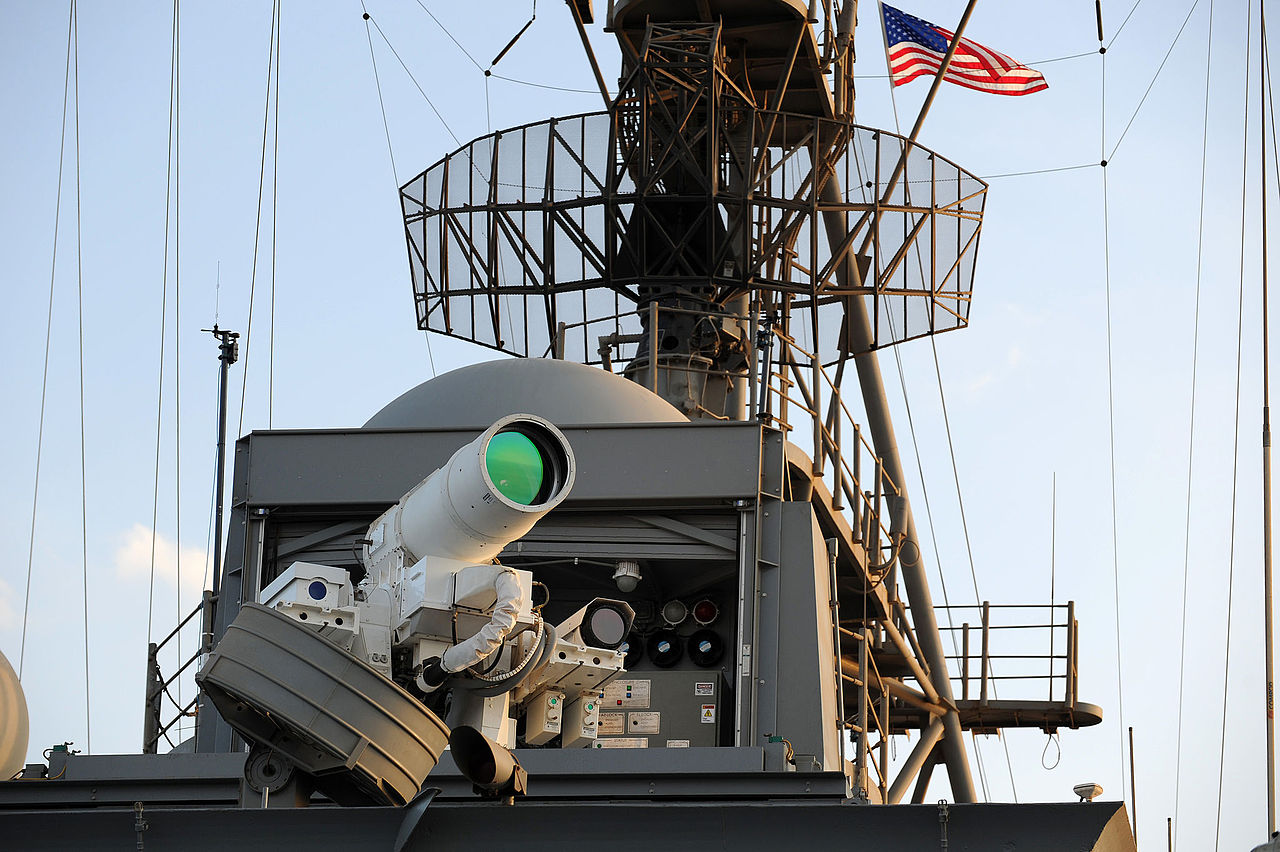One of the weapons currently on the horizon of naval warfare is the laser. While laser weapons have been discussed since the 60s, and the first laser weapons went to sea in the early 80s, it's only in the last decade that there's been a serious prospect of deploying lethal lasers in action. But there's a great deal of confusion around the potentials and limitations of laser weapons. How do they work, and what will they do to naval warfare?1

An Argentine aircraft attacks the British in the Falklands
Before I get to those questions, I should probably address something I'm sure many of you are asking about. Yes, the first operational laser weapons were deployed in the early 80s, aboard the ships of the Royal Navy. This device, known as Outfit DEC, was not designed to directly damage attackers. Instead, it was a blue-light optical dazzler, designed to blind the pilots of incoming aircraft. Even looking away wouldn't be enough, as the wavelength would cause the canopy to fluoresce. It is claimed that some ships deployed with Outfit DEC to the Falklands, and there are persistent rumors that several Argentine aircraft crashed while attacking the fleet as a result of their pilots being blinded. I am skeptical of this, as the air war has been extensively studied and every loss analyzed in detail. No Argentine aircraft flew into the terrain inside San Carlos water, and reports on Outfit DEC don't give the names of the pilots involved.2
The British kept Outfit DEC in service for another two decades, deploying it during the Persian Gulf War, although there are no solid reports of combat service. Growing concern over the danger of lasers causing permanent blindness lead to the Protocol on Blinding Laser Weapons in 1995, which bans any weapon intended to permanently blind the target. Temporary dazzlers are still allowed, and have seen some service, and this prohibition also does not apply to laser weapons intended to attack optical equipment, opening the way for systems like the Directional Infrared Countermeasures (DIRCM), a laser designed to blind IR-guided anti-air missiles. Of course, if a person were to end up looking at one of these systems, they would probably be blinded, and it's unclear to what extent laser attacks on devices like binoculars are allowed. In practice the effects of the ban are further limited because many systems designed for other purposes, such as rangefinding, are also capable of causing blindness at close range. Lasers are also a deniable weapon in operations short of war, and there are persistent reports of Russian and Chinese vessels and aircraft using lasers against ships and aircraft operating nearby. To counter this, laser-resistant glasses, which filter out specific frequencies, were developed and have been in reasonably wide use for the last quarter-century.

DIRCM turret on a C-17
But dazzlers are ultimately rather boring, and the new wave of weapons offers the capability to do direct damage. But before we start looking at these systems in detail, it's worth going into the basics of lasers and laser weaponry. Lasers are coherent light, with all of the waves lined up with each other, which allows them to be focused much more precisely than ordinary non-coherent light. A laser weapon requires both a system to generate a high-powered beam, and optics to direct said beam onto a target that could be several miles away. Until recently, high-powered lasers had to get their energy directly from chemical reactions, which meant using toxic and dangerous fuel. The current generation, drawing on technologies developed for the manufacturing industry, are solid-state and require only electricity and cooling, making them far easier and cheaper to operate. One of the key attractions of laser weapons is the possibility of disabling targets for a few dollars in fuel, instead of requiring a missile that costs hundreds of thousands or millions.
But that requires getting the beam from the ship to the target, which is more complicated than you might think. Sure, in space light travels in a straight line and you just need to make sure that your optics focus it at the correct point on the target.3 Things in an atmosphere, particularly when firing from a ship, are more complicated, as a number of effects make it hard to get the beam to the target in a state to do damage. The largest effect comes from the fact that changes in the density of the air that the beam passes through tend to spread it out. Some of this comes from normal, naturally-occurring turbulence, but far more is the result of the laser beam itself. Air isn't perfectly clear, even to visible light,4 and energy absorbed from the passing beam tends to turn it into a lens that spreads out the beam, a process known as blooming. Blooming is usually due to either water vapor or aerosols such as dust and soot. The aerosols also reduce beam strength in another way, as they tend to scatter energy out of the beam, particularly at shorter wavelengths. Adaptive optics hold the possibility to deal with some, although probably not all, blooming by distorting the mirror to compensate for the effects of density gradients.5

The AN/SEQ-3 aboard USS Ponce
But what happens when the beam reaches its target? Depending on power and duration, lasers can have all sorts of effects, but all current and projected naval lasers that are capable of doing serious material damage will use simple heating, depositing energy on the target until something bad happens to it. Exactly how long this takes will depend greatly on the target and the range, a subject I look at in more detail in a future installment, but reports suggest that the 30 kW laser deployed to the Persian Gulf aboard USS Ponce required on the order of 15 seconds to disable a drone. More power will be needed to be effective against missiles and airplanes, and work is underway on such systems.
But lasers have the potential to do more than just destroy things, and their flexibility is likely to prove vital in missions short of war. During her deployment, Ponce found that the optical system designed to focus the laser worked both ways, giving them an unprecedented view of anything nearby and making it significantly easier to figure out what a potentially hostile boat or aircraft was up to. Nor is that the only less-than-lethal capability that comes with the laser. It can be fired at low power to provide a harmless "warning shot" or to temporarily blind electro-optical surveillance equipment. These roles would generally involve routing the beam through a frequency-doubling crystal to place it in the visible spectrum instead of IR. There are also some other options beyond simple melting on the more destructive end of the spectrum. Many forms of electro-optical equipment, such as missile seekers, are quite vulnerable to laser damage, and if that isn't enough, the ability of a laser to heat the target can be used to make it easier for a traditional IR-homing missile to see even if it's too far for direct laser damage.6 And when simple destruction is the objective, the laser gives new capabilities thanks to its precision. It can easily disable the motor of a potentially hostile boat, while leaving the crew unharmed, or cook off the warhead of an RPG, multiplying its direct effect among nearby enemies.
But all of this still leaves the question of what these lasers are actually capable of. Public sources are long on generalities about UAVs, boats and missiles, and short on any sort of hard numbers. Fortunately, this is a case where most of the information we need to get a much better handle on the situation is already in the public domain, provided you know where to look, and next time, I will unpack what we might be able to expect from current and future naval lasers.
1 I'm going to ignore other uses of lasers, most notably as part of targeting systems. ⇑
2 Norman Friedman suggests that Outfit DEC was developed as a crash program in response to the Argentine air attacks at San Carlos instead, which makes a lot more sense. The most detailed report on Outfit DEC can be found here. I disagree with their conclusion on the Falklands, but the rest looks solid. ⇑
3 This is often misunderstood. A laser doesn't produce a perfectly-focused beam, and diffraction sets the minimum possible spot size at a given range. To reach the diffraction-limited spot size, the laser needs to focus at that specific range. In practice, most current military lasers have a theoretical "beam quality" (the ratio of the actual spot diameter to diffraction-limited spot diameter) of 2-5, but smaller values don't matter much because of atmospheric effects. ⇑
4 Although it's worth pointing out that most military lasers so far seem to work in short IR, with wavelengths of between 1 and 2 um. ⇑
5 See this paper for all the details you could want on atmospheric laser propagation. ⇑

Comments
15 s sounds a bit long if something is incoming, but if the range is long enough maybe it could work, at least if it isn't a saturation attack.
The drone in question was a ScanEagle, not anything armed. The current systems are far more for countersurveillance than for missile defense. I go into a lot more detail in the next part.
To state the obvious, LASERs have no over-the-horizon ability, and thus are outranged by 6" guns?
You can mitigate the line of sight issue by putting the laser higher up. I can't find hard numbers for mast height from the waterline on an Arleigh Burke, but it looks like about twice the beam in picture s, which would make it about 125 ft. At that height, the horizon is 13.7 statute miles or 11.9 nautical miles away, which is less than the range of the 5" gun (13 nm on older ships, 20 nm on newer ones), but not outrageously so. If you're shooting at a spot above the waterline, you'll still have line-of-sight a bit past the horizon.
On a Ford-class carrier, the top of the mast is 250 ft from the waterline, putting the horizon 16.8 nautical miles away.
The big win it terms of range for a laser is if you're shooting at something that's up in the air, like a plane or a missile. It your target is one nmi up in the air, your laser will have line-of-sight on it from at least 80 nmi away. Likewise, if you can put a good laser weapon on a plane, it'll be able to get line of sight on targets really far out. I expect the limiting factor on range for a plane-mounted laser is going to be dispersion, not the horizon.
For the next decade or two at least, line-of-sight and the horizon isn’t going to dominate laser range. I go into excruciating detail on this in the next post, but the current systems in particular probably have effective ranges in the single-digit km due to the propagation stuff I summarized here.
It is funny to think of the ship-of-the-future, nuclear powered, LASER armed. It is invincible to missiles and aircraft and helpless before solid shot from medium guns.
Until recently, high-powered lasers had to get their energy directly from chemical reactions,
CO2 lasers have been one of the most common high powered lasers for decades, and they are electrically powered. YAG lasers too, which are the ones used for the fusion experiments. Though YAG lasers never seem to be small enough for any normal application.
It is funny to think of the ship-of-the-future, nuclear powered, LASER armed. It is invincible to missiles and aircraft and helpless before solid shot from medium guns.
Then the lasers get powerful enough to deflect even solid shot, and we have to resort to rams. Yet again.
@Doctorpat
15 years ago, most prominent laser weapons programs were chemical, not solid state. I was trying to distinguish those from things like targeting pod lasers, which have been solid state for far longer.
Carbon dioxide lasers have wavelengths an order of magnitude greater than typical solid-state or chemical lasers, which makes them ill-suited for applications that require focusing over long distances. Also, there's enough CO2 in the atmosphere for significant absorption and thus thermal blooming. They're great as an industrial tool for e.g. cutting steel plate on a working surface half a meter from the laser head, not so much if the thing you're trying to cut is kilometers away. They've never been a serious contender as weapons.
If bloom due to water vapor is a problem, how do military laser designers propose to handle rain, spray, and things like that?
Lasers don't work very well in those cases, which is why they won't take over everything.
Aren't counter-measures against lasers relatively easy? Mirror or ablative coatings. Smoke.
I remember the comedy sci-fi novel 'Who Goes Here?', by Bob Shaw, where laser rifles are completely ineffective due to the smoke generated by low-tech enemy machine guns. This is considered very unsporting.
Mirrors are not 100% reflective so will heat up if hit with a laser, with enough power you'll melt or vaporize it.
Ablative coatings by design will not last forever against a laser.
Smoke drifts away over time and machine guns run out of ammunition.
@Andy B
I cover all of this is Part 3. There are some useful countermeasure, but nothing that's a slam-dunk against lasers.